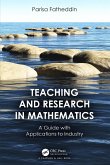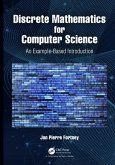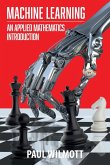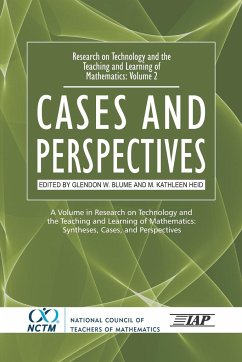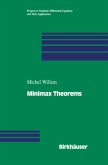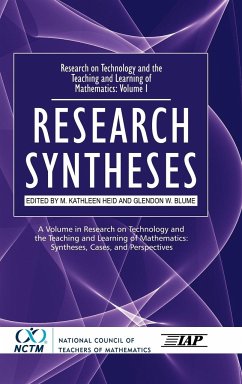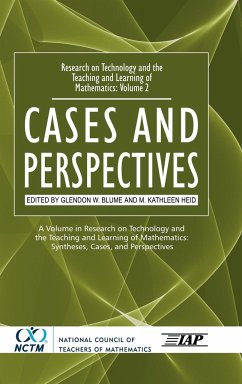Teaching and Learning Mathematics Online
Herausgeber: Howard II, James P.; Beyers, John F.
Teaching and Learning Mathematics Online
Herausgeber: Howard II, James P.; Beyers, John F.
- Gebundenes Buch
- Merkliste
- Auf die Merkliste
- Bewerten Bewerten
- Teilen
- Produkt teilen
- Produkterinnerung
- Produkterinnerung
This second edition continues to present meaningful and practical solutions for teaching mathematics and statistics online, focusing on the problems observed by mathematics instructors currently working in the field. With its set of standard practices, instructors will benefit from learning many new techniques and approaches.
Andere Kunden interessierten sich auch für
![Teaching and Research in Mathematics Teaching and Research in Mathematics]() Parisa FatheddinTeaching and Research in Mathematics81,99 €
Parisa FatheddinTeaching and Research in Mathematics81,99 €![Discrete Mathematics for Computer Science Discrete Mathematics for Computer Science]() Jon Pierre FortneyDiscrete Mathematics for Computer Science185,99 €
Jon Pierre FortneyDiscrete Mathematics for Computer Science185,99 €![Machine Learning Machine Learning]() Paul WilmottMachine Learning20,99 €
Paul WilmottMachine Learning20,99 €![Research on Technology and the Teaching and Learning of Mathematics Research on Technology and the Teaching and Learning of Mathematics]() Research on Technology and the Teaching and Learning of Mathematics69,99 €
Research on Technology and the Teaching and Learning of Mathematics69,99 €![Minimax Theorems Minimax Theorems]() Michel WillemMinimax Theorems107,99 €
Michel WillemMinimax Theorems107,99 €![Research on Technology and the Teaching and Learning of Mathematics Research on Technology and the Teaching and Learning of Mathematics]() Research on Technology and the Teaching and Learning of Mathematics114,99 €
Research on Technology and the Teaching and Learning of Mathematics114,99 €![Research on Technology and the Teaching and Learning of Mathematics Research on Technology and the Teaching and Learning of Mathematics]() Research on Technology and the Teaching and Learning of Mathematics114,99 €
Research on Technology and the Teaching and Learning of Mathematics114,99 €-
-
-
This second edition continues to present meaningful and practical solutions for teaching mathematics and statistics online, focusing on the problems observed by mathematics instructors currently working in the field. With its set of standard practices, instructors will benefit from learning many new techniques and approaches.
Produktdetails
- Produktdetails
- Verlag: Chapman and Hall/CRC
- 2. Auflage
- Seitenzahl: 696
- Erscheinungstermin: 30. Juni 2025
- Englisch
- Abmessung: 260mm x 183mm x 42mm
- Gewicht: 1482g
- ISBN-13: 9781032497754
- ISBN-10: 1032497750
- Artikelnr.: 72111812
- Herstellerkennzeichnung
- Libri GmbH
- Europaallee 1
- 36244 Bad Hersfeld
- gpsr@libri.de
- Verlag: Chapman and Hall/CRC
- 2. Auflage
- Seitenzahl: 696
- Erscheinungstermin: 30. Juni 2025
- Englisch
- Abmessung: 260mm x 183mm x 42mm
- Gewicht: 1482g
- ISBN-13: 9781032497754
- ISBN-10: 1032497750
- Artikelnr.: 72111812
- Herstellerkennzeichnung
- Libri GmbH
- Europaallee 1
- 36244 Bad Hersfeld
- gpsr@libri.de
James P. Howard, II is a multifaceted professional with extensive experience in data science, consulting, teaching, and community service. He has previously worked as a consultant to various United States government agencies, including the Securities and Exchange Commission, the Executive Office of the President, and the Department of Homeland Security. Additionally, he served as an internal consultant on scientific computing for the Board of Governors of the Federal Reserve System. Dr. Howard is also deeply committed to education, having taught mathematics and statistics at the University of Maryland Global Campus since 2010, as well as public affairs at other institutions. His career highlights include involvement in innovative projects such as modeling the spread of infectious diseases, predicting global events, researching blockchain applications in government, and designing rescue devices for building collapse scenarios. He has authored and cöedited several books on these subjects. John F. Beyers, PhD, is Program Chair and Professor of Mathematics and Statistics at the University of Maryland Global Campus (formerly UMUC). Dr Beyers leads a global department of 200+ faculty to serve the educational needs of over 20,000 non-traditional, underrepresented undergraduate students globally. He is responsible for new program development, curriculum planning, teaching effectiveness and Learning Outcomes Assessment. Prior to his current position, Dr Beyers was the Associate Director for the Center of Distance Education at Johns Hopkins University. Dr Beyers has an extensive academic background as a faculty member and leader of one of the largest online mathematics and statistics departments in the country. While earning a PhD in mathematics education from American University (his dissertation was the first to earn "pass with distinction" in over two decades), Dr Beyers began his career in innovative education as Research Coordinator on the NCTM Standards 2000Project, which resulted in the national standards document Principles and Standards for School Mathematics (NCTM, 2000). He later worked with post-secondary students and faculty at Johns Hopkins University's Center for Distance Education on innovative distance education models to determine how difficult/easy is it for faculty to embed or integrate technologies into a course and in harmony with their pedagogic model. Dr Beyers has been recognized for his efforts as an innovative academic leader in higher education. In 2012, he received the UMUC Presidential Award and the University System of Maryland's Faculty Fellowship Award from the Chancellor's Office. In 2007, he received the Adelle F Robertson National Educator of the Year Award (UPCEA) and in 2006, he received the Alexander Charters Mid-Atlantic Region Educator of the Year Award (UPCEA). Dr Beyers has published and presented extensively on the topics of course redesign, adaptive and accelerated learning models, distance learning, and mathematics education. His current interest is focused on how adaptive learning can be used to deepen the quality of faculty-student engagement and enable development of higher order thinking skills. Dr Beyers has an extensive network of academic colleagues and adaptive learning vendors to establish an Adaptive Resources Community (ARC).
Part 1: Course Design
Chapter 1: Teaching Cross-Listed Mathematics Courses Online
Chapter 2: What Do We Know about Student Learning from Online Mathematics Homework?
Chapter 3: Designing mathematics hybrid classrooms in high school: the case of Valeria
Chapter 4: Designing mathematics hybrid classrooms in high school: the cases of Nicoletta and Lorenza
Chapter 5: Upper-Level Mathematics and Statistics Courses Shared Across Campuses
Chapter 6: Online Statistics Teaching and Learning
Chapter 7: Statistics for Engineers
Chapter 8: Emphasizing Active Learning and Conceptual Understanding in Asynchronous and Synchronous Online Settings: Practical Strategies and Challenges
Chapter 9: The evolution of assessing content knowledge in online mathematics courses
Part 2: Student Interaction
Chapter 10: Encouraging higher-order thinking in online and hybrid mathematics and statistics courses
Chapter 11: Tools for communication and interaction in online mathematics teaching and learning
Chapter 12: Managing Students' Mathematics Anxiety in the Context of Online Learning Environments
Chapter 13: A Face-to-Face Program of Support for Students in a Hybrid Online Developmental Mathematics Course
Chapter 14: A Practical Guide to Discussions in Online Mathematics Courses
Chapter 15: Three Cases Representing a Variety of Online
Post-Secondary Mathematics Tutoring Interactions
Chapter 16: Online Discussion Forums in Discrete Mathematics Courses: Promising Affordances
Chapter 17: A Framework for Analyzing Asynchronous Discussion Activities
Part 3: Using Technology
Chapter 18: Cognitive Load Theory and Mathematics Instruction through MOOCs
Chapter 19: Technological Pedagogical Content Knowledge for Meaningful Learning and Instrumental Orchestrations: A Case Study of a Cross Product Exploration using CalcPlot3D
Chapter 20: Enhancement of Mathematics Learning through Novel Online Tools
Chapter 21: Making Online Mathematics Method Courses Interactive and Effective with OER
Chapter 22: Developing Interactive Demonstrations for the Online Mathematics Classroom: Interactive Diagrams
Chapter 23: Effective Design and Use of Video for Learning Mathematics
Chapter 24: COVID-19 Impact on Digital Resource Use in Secondary Mathematics Instruction
Chapter 25:
Chapter 26: Theoretical principles for the design of multimedia learning resources that stimulate students' experience of intellectual need
Part 4: Teacher Education
Chapter 27: MOOCs for mathematics teacher education: new environments for professional development
Chapter 28: Online Mathematics "Self-Help Kiosks" to Support Pre-Service Teachers
Part 5: Commentary
Chapter 29: Online mathematics education
the good
the bad
and the general overview
Chapter 1: Teaching Cross-Listed Mathematics Courses Online
Chapter 2: What Do We Know about Student Learning from Online Mathematics Homework?
Chapter 3: Designing mathematics hybrid classrooms in high school: the case of Valeria
Chapter 4: Designing mathematics hybrid classrooms in high school: the cases of Nicoletta and Lorenza
Chapter 5: Upper-Level Mathematics and Statistics Courses Shared Across Campuses
Chapter 6: Online Statistics Teaching and Learning
Chapter 7: Statistics for Engineers
Chapter 8: Emphasizing Active Learning and Conceptual Understanding in Asynchronous and Synchronous Online Settings: Practical Strategies and Challenges
Chapter 9: The evolution of assessing content knowledge in online mathematics courses
Part 2: Student Interaction
Chapter 10: Encouraging higher-order thinking in online and hybrid mathematics and statistics courses
Chapter 11: Tools for communication and interaction in online mathematics teaching and learning
Chapter 12: Managing Students' Mathematics Anxiety in the Context of Online Learning Environments
Chapter 13: A Face-to-Face Program of Support for Students in a Hybrid Online Developmental Mathematics Course
Chapter 14: A Practical Guide to Discussions in Online Mathematics Courses
Chapter 15: Three Cases Representing a Variety of Online
Post-Secondary Mathematics Tutoring Interactions
Chapter 16: Online Discussion Forums in Discrete Mathematics Courses: Promising Affordances
Chapter 17: A Framework for Analyzing Asynchronous Discussion Activities
Part 3: Using Technology
Chapter 18: Cognitive Load Theory and Mathematics Instruction through MOOCs
Chapter 19: Technological Pedagogical Content Knowledge for Meaningful Learning and Instrumental Orchestrations: A Case Study of a Cross Product Exploration using CalcPlot3D
Chapter 20: Enhancement of Mathematics Learning through Novel Online Tools
Chapter 21: Making Online Mathematics Method Courses Interactive and Effective with OER
Chapter 22: Developing Interactive Demonstrations for the Online Mathematics Classroom: Interactive Diagrams
Chapter 23: Effective Design and Use of Video for Learning Mathematics
Chapter 24: COVID-19 Impact on Digital Resource Use in Secondary Mathematics Instruction
Chapter 25:
Chapter 26: Theoretical principles for the design of multimedia learning resources that stimulate students' experience of intellectual need
Part 4: Teacher Education
Chapter 27: MOOCs for mathematics teacher education: new environments for professional development
Chapter 28: Online Mathematics "Self-Help Kiosks" to Support Pre-Service Teachers
Part 5: Commentary
Chapter 29: Online mathematics education
the good
the bad
and the general overview
Part 1: Course Design
Chapter 1: Teaching Cross-Listed Mathematics Courses Online
Chapter 2: What Do We Know about Student Learning from Online Mathematics Homework?
Chapter 3: Designing mathematics hybrid classrooms in high school: the case of Valeria
Chapter 4: Designing mathematics hybrid classrooms in high school: the cases of Nicoletta and Lorenza
Chapter 5: Upper-Level Mathematics and Statistics Courses Shared Across Campuses
Chapter 6: Online Statistics Teaching and Learning
Chapter 7: Statistics for Engineers
Chapter 8: Emphasizing Active Learning and Conceptual Understanding in Asynchronous and Synchronous Online Settings: Practical Strategies and Challenges
Chapter 9: The evolution of assessing content knowledge in online mathematics courses
Part 2: Student Interaction
Chapter 10: Encouraging higher-order thinking in online and hybrid mathematics and statistics courses
Chapter 11: Tools for communication and interaction in online mathematics teaching and learning
Chapter 12: Managing Students' Mathematics Anxiety in the Context of Online Learning Environments
Chapter 13: A Face-to-Face Program of Support for Students in a Hybrid Online Developmental Mathematics Course
Chapter 14: A Practical Guide to Discussions in Online Mathematics Courses
Chapter 15: Three Cases Representing a Variety of Online
Post-Secondary Mathematics Tutoring Interactions
Chapter 16: Online Discussion Forums in Discrete Mathematics Courses: Promising Affordances
Chapter 17: A Framework for Analyzing Asynchronous Discussion Activities
Part 3: Using Technology
Chapter 18: Cognitive Load Theory and Mathematics Instruction through MOOCs
Chapter 19: Technological Pedagogical Content Knowledge for Meaningful Learning and Instrumental Orchestrations: A Case Study of a Cross Product Exploration using CalcPlot3D
Chapter 20: Enhancement of Mathematics Learning through Novel Online Tools
Chapter 21: Making Online Mathematics Method Courses Interactive and Effective with OER
Chapter 22: Developing Interactive Demonstrations for the Online Mathematics Classroom: Interactive Diagrams
Chapter 23: Effective Design and Use of Video for Learning Mathematics
Chapter 24: COVID-19 Impact on Digital Resource Use in Secondary Mathematics Instruction
Chapter 25:
Chapter 26: Theoretical principles for the design of multimedia learning resources that stimulate students' experience of intellectual need
Part 4: Teacher Education
Chapter 27: MOOCs for mathematics teacher education: new environments for professional development
Chapter 28: Online Mathematics "Self-Help Kiosks" to Support Pre-Service Teachers
Part 5: Commentary
Chapter 29: Online mathematics education
the good
the bad
and the general overview
Chapter 1: Teaching Cross-Listed Mathematics Courses Online
Chapter 2: What Do We Know about Student Learning from Online Mathematics Homework?
Chapter 3: Designing mathematics hybrid classrooms in high school: the case of Valeria
Chapter 4: Designing mathematics hybrid classrooms in high school: the cases of Nicoletta and Lorenza
Chapter 5: Upper-Level Mathematics and Statistics Courses Shared Across Campuses
Chapter 6: Online Statistics Teaching and Learning
Chapter 7: Statistics for Engineers
Chapter 8: Emphasizing Active Learning and Conceptual Understanding in Asynchronous and Synchronous Online Settings: Practical Strategies and Challenges
Chapter 9: The evolution of assessing content knowledge in online mathematics courses
Part 2: Student Interaction
Chapter 10: Encouraging higher-order thinking in online and hybrid mathematics and statistics courses
Chapter 11: Tools for communication and interaction in online mathematics teaching and learning
Chapter 12: Managing Students' Mathematics Anxiety in the Context of Online Learning Environments
Chapter 13: A Face-to-Face Program of Support for Students in a Hybrid Online Developmental Mathematics Course
Chapter 14: A Practical Guide to Discussions in Online Mathematics Courses
Chapter 15: Three Cases Representing a Variety of Online
Post-Secondary Mathematics Tutoring Interactions
Chapter 16: Online Discussion Forums in Discrete Mathematics Courses: Promising Affordances
Chapter 17: A Framework for Analyzing Asynchronous Discussion Activities
Part 3: Using Technology
Chapter 18: Cognitive Load Theory and Mathematics Instruction through MOOCs
Chapter 19: Technological Pedagogical Content Knowledge for Meaningful Learning and Instrumental Orchestrations: A Case Study of a Cross Product Exploration using CalcPlot3D
Chapter 20: Enhancement of Mathematics Learning through Novel Online Tools
Chapter 21: Making Online Mathematics Method Courses Interactive and Effective with OER
Chapter 22: Developing Interactive Demonstrations for the Online Mathematics Classroom: Interactive Diagrams
Chapter 23: Effective Design and Use of Video for Learning Mathematics
Chapter 24: COVID-19 Impact on Digital Resource Use in Secondary Mathematics Instruction
Chapter 25:
Chapter 26: Theoretical principles for the design of multimedia learning resources that stimulate students' experience of intellectual need
Part 4: Teacher Education
Chapter 27: MOOCs for mathematics teacher education: new environments for professional development
Chapter 28: Online Mathematics "Self-Help Kiosks" to Support Pre-Service Teachers
Part 5: Commentary
Chapter 29: Online mathematics education
the good
the bad
and the general overview


